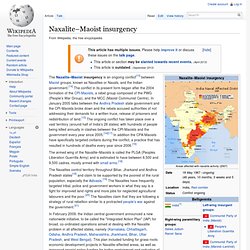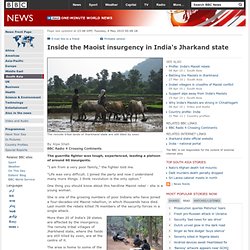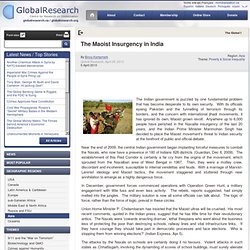

Naxalite-Maoist insurgency. The armed wing of the Naxalite–Maoists is called the PLGA (Peoples Liberation Guerrilla Army) and is estimated to have between 6,500 and 9,500 cadres, mostly armed with small arms.[18] The Naxalites control territory throughout Bihar, Jharkand and Andhra Pradesh states[18] and claim to be supported by the poorest of the rural population, especially the Adivasis.[19] The Naxalites have frequently targeted tribal, police and government workers in what they say is a fight for improved land rights and more jobs for neglected agricultural labourers and the poor.[20] The Naxalites claim that they are following a strategy of rural rebellion similar to a protracted people's war against the government.[21] The Naxalite–Maoist insurgency gained international media attention after the 2013 Naxal attack in Darbha valley resulted in the deaths of around 24 Indian National Congress leaders including the former state minister Mahendra Karma and the Chhattisgarh Congress chief Nand Kumar Patel.[29]

Inside the Maoist insurgency in India's Jharkand state. The remote tribal lands of Jharkhand state are still tilled by oxen The guerrilla fighter was tough, experienced, leading a platoon of around 60 insurgents.

"I am from a very poor family," the fighter told me. "Life was very difficult. I joined the party and now I understand many more things. I think revolution is the only option. " One thing you should know about this hardline Maoist rebel - she is a young woman. She is one of the growing numbers of poor Indians who have joined a four-decades-old Maoist rebellion, in which thousands have died. The Maoist Insurgency in India. The Indian government is puzzled by one fundamental problem that has become desperate to its own security.

With its officials eyeing Pakistan and the funnelling of terrorism through its borders, and the concern with international jihadi movements, it has ignored its own, Maoist grown revolt. Anywhere up to 6,000 people have perished in the Naxalite insurgency of the last 20 years, and the Indian Prime Minister Manmohan Singh has decided to place the Maoist movement’s threat to Indian security at the forefront of public and official debate. Near the end of 2009, the central Indian government began implanting forceful measures to combat the Naxals, who now have a presence in 180 of Indians 626 districts (Guardian, Dec 6, 2009).
Maoist insurgents in India: More bloody and defiant. India's Failing Counterinsurgency Campaign - By Anuj Chopra. Tapping his fingernails on a tiny stainless steel lunch box, Comrade Vijay, a mustachioed rebel commander, made a startling assertion: There was enough bomb material inside to blow up a jeep.

With 90 pounds of such explosives, he claimed, his comrades in the Indian Maoist rebel army had blown up land-mine-resistant armored vehicles the Indian government imported from South Africa. Improvised Explosive Devices (IEDs) are the "main strength" of the rebels, he told me, as he sat under a makeshift tarpaulin tent, rifle at his side. Last October, on assignment for Abu Dhabi's National newspaper, I hiked more than 40 miles through the damp, malarial jungles of Bastar in central India, the deadliest theater of the country's decades-long Maoist insurgency, winding through mineral-rich hills and a spate of rebel-controlled villages to Comrade Vijay's hideout in a patch of forest clearing atop a hill.
Now the neglect is coming back to haunt India's security forces. Indian minister: Maoists are a greater threat than Islamic terrorists. The Indian government is preparing to deploy thousands of soldiers to defeat the country's growing Naxalite Maoist insurgency. Home minister P Chidambaram's description of the threat posed by the Naxalites was striking: The Home Minister told a media conclave in Delhi that the Maoists and Islamic militants represented the two biggest threats to India’s national security, but the former was the more serious. “Jihadi terrorism can be countered, usually successfully, if you are able to share information and act in real time,” he said. “But Maoism is an even graver threat.” The numbers back up Chidambaram's claim: India has suffered only one attack by suspected Islamist militants - a bombing in the western city of Poona which killed 12 people last month - since the devastating one on Mumbai in November 2008.
Chidambaram pledged that the Maoist threat would be eliminated in two to three years, which seems ambitious given that they're operating in 200 of India’s 626 districts. Fire in the Hole - By Jason Miklian and Scott Carney. View a photo essay on India's hidden war The richest iron mine in India was guarded by 16 men, armed with Army-issued, self-loading rifles and dressed in camouflage fatigues.

Only eight survived the night of Feb. 9, 2006, when a crack team of Maoist insurgents cut the power to the Bailadila mining complex and slipped out of the jungle cover in the moonlight. The guerrillas opened fire on the guards with automatic weapons, overrunning them before they had time to take up defensive positions.
They didn't have a chance: The remote outpost was an hour's drive from the nearest major city, and the firefight to defend it only lasted a few minutes.